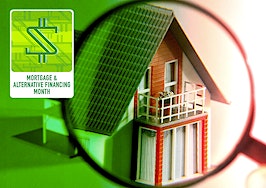 We want to help you make more money — right now. All month, go Back to Basics with Inman as real estate pros share what’s working now and how they’re setting up to profit in a post-pandemic world.
We want to help you make more money — right now. All month, go Back to Basics with Inman as real estate pros share what’s working now and how they’re setting up to profit in a post-pandemic world.
It is no secret our nation is struggling with affordable housing, especially in those states with the highest housing prices. One of the most visible signs is the dramatic increase, over the past couple of years, in the homeless populations in many of our country’s urban centers.
Last month, the Department of Housing and Urban Development released a report showing the “devastating” growth in people experiencing homelessness “even before the pandemic,” according to NPR.
Of course, COVID-19 certainly has not helped. In the San Francisco Bay Area, it is almost impossible to go anywhere without seeing homeless encampments along freeway access ramps, overcrossings and more. Side streets in industrial areas, whose sole residents after working hours and weekends used to be lines of off-duty trucks, now house row upon row of various types of RVs, some permanently stationed.
As the crisis deepens and the gap between those who can afford housing and those who cannot grows further apart, we have seen an increase in homeless activities targeted at our listings. In my first 15 years in the business, the only “unlawful occupants” we had to contend with were cats, possums, rats and a raccoon or two. Now, the number of unlawful entries by uninvited people seeking shelter is on the rise.
In some cases, these visitors simply want a place to shelter out of the weather, use the restrooms and get a shower. In other cases, on the other end of the scale, they are looking for a place to store drugs or have “relations.”
We have had some of our listings broken into three times, seen items stolen (in one case, 20 solar panels), had staging trashed, toilets completely plugged, holes busted in the walls, windows broken and things generally messed up.
It is important to understand one key fact: Over the years, we have had break-ins where thieves were targeting the belongings in the home. What we are seeing now is different and has more to do with persons gaining access for shelter.
We actually had one individual break in and then change the locks to prevent us front reclaiming the home. Another resourceful person conjured up fake copies of a lease, while yet another produced documents indicating he had “purchased” the home.
The obvious place to begin, once you have discovered your listing as uninvited guests is to contact the local police to get their support. They will help remove squatters, and in one case, after repeated encounters, the police even removed a nearby encampment whose residents were trying to take over our seller’s home.
5 key steps to take after securing a home
1. Secure the property
Once the police have determined the home is no longer occupied, go through it, and do an in-depth assessment of any potential damage. In addition, we check all the windows. In almost every instance of a break-in, the perpetrators have left any number of windows unlocked in the event we get wise and change the locks.
Check every window, and install additional window security measures (dowels, edge locks, etc.) as needed. We have a couple different locksmiths we call in emergencies who will respond quickly to get the home secured again. They not only rekey locks, but they can also get us access as necessary.
2. Repair any damage
This can be the most frustrating part of the process. It is bad enough that the home has been accessed, fixing things after the fact is demoralizing, especially if it is from random acts of vandalism.
If the home is in escrow, getting the repairs completed correctly and in a timely manner is critical.
3. Increase security measures
Determine what actions will be best to prevent further unauthorized entries. (See the five recommended items in the next section.)
4. Clean and sanitize the home
In some cases, it is necessary to clean up messes left behind. If the home is pending, the buyers may want to know that the home has been sanitized — especially in today’s pandemic environment.
5. Disclose the entry to the buyers
This will vary from state to state, but in our region, if the home is in contract, we need to report any incidents to the buyers in writing. In some cases, depending on the activity, this gives buyers a potential reason to cancel the transaction.
Once you have secured your listing, there are things you can do to prevent further issues. Here are our five suggestions:
How to prevent further issues
1. Consider increasing the level of monitoring
This can be as simple as going by the listing every day. Make sure doors and windows are locked, and check for any sign of access. Frequently, just having someone visiting on a regular basis is enough to keep intruders at bay.
Make sure you do not go alone. A second way of monitoring a home is to get the neighbors involved. Many neighborhoods have residents who are concerned about safety and will be happy to keep an eye on things.
2. Consider installing alarms
In many urban areas, police no longer respond to home security alarms. Neighbors, however, do. If you have taken the time to build relationships with the neighbors, they are often willing to respond when an alarm goes off.
3. Consider making yard signs ‘optional’
Yard signs can be a magnet for those looking for a vacant place to reside. We have learned in recent years that there are some areas in which it is simply unwise to advertise your listing.
Additionally, with most listings plastered all over the internet, yard signs are not as important as they used to be. Although it’s nice to be able to advertise yourself in the neighborhood, you can achieve the same effect with mailers.
4. Consider installing temporary residents
For those properties that seem prone to forced entry, we have started providing temporary occupants to look after the place. There are always those who are between “situations” — sometimes college kids or others in the midst of relocating. Having someone in the home is the best deterrent we have discovered.
5. Consider removing combo lockboxes that can be broken into
All of our listings have two lockboxes: the real estate lock box (SUPRA) and a second combo box for the trades. We have over 50 copies of a well-known lockbox and to our horror, just discovered how easy they are to break into.
With one well-placed blow of a hammer, it is possible to break the front panel, providing access to the key. Going forward, we will be removing these boxes as soon as possible and just leaving the SUPRAs in place.
With the rise in homelessness, listing agents need to become increasingly diligent in securing their listings. Although you might not have seen any incidents as of yet, the odds are that the more homes you sell, the more likely you will encounter unwanted occupants trying to move in and secure the home for themselves.
Carl Medford is the CEO of The Medford Team.








